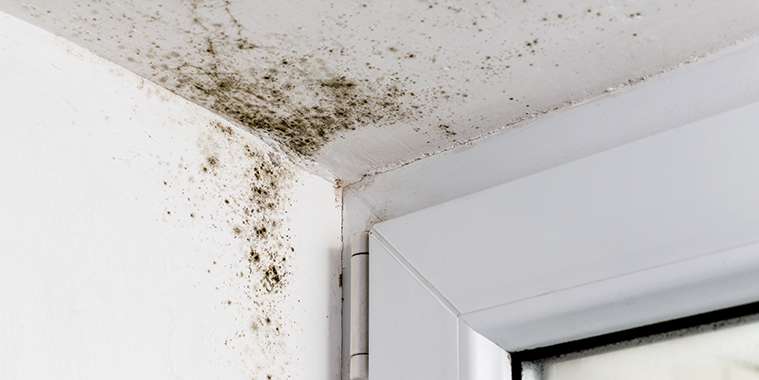Nothing mars a beautiful home interior more than the unwanted incursion of mould. Mould’s reputation carries with it more than just an unsightly appearance — it can cause serious illness, and if left unchecked can result in costly repairs. Let’s take a closer look at what mould is, how to prevent it, and what to do if you find it in your home.
What is mould, anyway?
Mould is the term used to describe fungus that grows on food and in damp environments in our homes, presenting in patches of dark grey, green, black or white. Although spores exist naturally in our environment and are ever-present in the air we breathe, when conditions are right for their growth, they can become a concern in our homes.
Mould and mildew are often used as two distinct terms, though both describe fungi which we find in our homes. The difference is mildew grows on surfaces causing only cosmetic damage, while mould (referring to toxic fungus) spreads more easily, penetrating building materials and can cause structural damage, and severe illnesses.
What moulds can make you sick?
Paul Quirouette, a branch manager for Canada’s Restoration Services with 17 years in the industry, says even though most common moulds are harmless and exist in the air we breathe, there are six types of toxic moulds with potentially severe health effects.
Stachybotrys: Referred to as black mould, this is the most dangerous of the toxic moulds, bearing a musty, dank odour. “It can cause flu-like symptoms, diarrhea, headaches, memory loss and severe respiratory damage,” says Quirouette. Children are at higher risk of respiratory illness due to their developing lungs.
Chaetomium: Usually found where water damage has occurred, this variety thrives in dark, wet environments like drywall, wallpaper, baseboards and carpeting. It’s similar to stachybotrys, often growing in the same environment, causing allergy symptoms like red, watery eyes, trouble breathing, and even neurological damage and autoimmune illnesses.
Aspergillus: While its spores are present in the air we breathe, this mould variety can be detrimental to a compromised immune system. Exposure can result in allergic reactions, and lung infections including a specific and serious infection known as aspergillosis.
Penicillium: Much like aspergillus, penicillium exists abundantly in our environment, but can cause asthmatic symptoms, bronchitis and other respiratory problems if trapped in our homes in certain conditions.
Fusarium: This type of mould is normally found in soil and plant debris, though it may also be found in very damp indoor areas like under carpeting, inside drywall, foam insulation, humidifier pans and HVAC systems. Fusarium spores in rare cases cause fusarium keratitis, a serious eye infection.
Alternaria: This allergy-causing mould is prevalent in many climate zones during spring and summer.Although it’s not generally found in building materials, it can grow on most damp surfaces in the home, and most notably can be found in electric cables, cardboard, some synthetics and textiles.
What are common causes of mould incursion?
We know mould prefers damp environments, but it doesn’t take much to create a suitable scenario for incursion. Quirouette reveals the most common causes of mould incursion are:
• persistent humidity;
• leaky pipes;
• a leaky roof;
• condensation build-up;
• poor ventilation;
• wet laundry;
• flooding; and
• damp basements.
He advises caution when it comes to previous flooding. Years can pass with no issues, but as soon as the right humidity conditions occur, dormant mould spores can reactivate.
How can you detect mould?
Detecting mould can be tricky because it’s not always visible. It’s only when it blooms and spreads that it becomes easily detectable. Dank, musty, or mildew odours are good indicators of possible mould problems.
Quirouette advises, “Mould spreads, so be sure to check all rooms in your home, especially dark and damp areas like the basement. Also check under the carpeting, flooring and behind wallpaper or drywall.”
But what if I can’t see or smell any mould? If you or your family members have persistent allergy, cold or flu symptoms that subside when away from the house for any length of time, it could be an indicator of mould in your home. While mould test kits can be purchased, it’s a good idea to seek a professional to investigate further.
Dealing with mould
If you’ve discovered a small spot of mould, it’s possible to address it safely on your own. Quirouette recommends, “warm soapy water to help get deeper into semi-porous surfaces then use undiluted white vinegar to neutralize the bacteria that causes mould spores.”
Large or widespread incursions, require a mould remediation professional, and it’s best not to disturb it further. If you attempt this scenario solo, Quirouette warns you risk spreading the spores, feeding the mould—cleaners are often diluted using water which is what mould eats!—causing further structural damage. You can also miss something and have to remediate again, or become ill from breathing in the spores.
An ounce of prevention
As the old adage goes—there are some key things you can do to keep mould incursions out of your home, saving you a pound of cure down the road.
• Do not allow wet materials to sit: Mould needs less than 48 hours to start growing, so never leave damp laundry or towels laying around.
• Keep household surfaces clean: Quirouette recommends giving surfaces in your home—especially around sinks, tubs and tiles in your kitchen and bathroom—a good cleaning, disinfection and drying. Leaving dry surfaces after each cleaning is key.
• Reduce moisture levels in your home: Always run the exhaust fan during and after showering in your bathroom or when cooking in the kitchen to minimize moisture levels.
• Stow your belongings securely: Store seasonal items in secure bins with tight-closing lids to keep moisture out. Be sure to store any gear or boxes in a way that allows adequate airflow between them.
• Maintain your plumbing: Monitor your plumbing, and repair or replace as needed to prevent leaky or weeping pipes.
• Optimize airflow in your home: Keep furniture away from walls and open windows when possible to allow natural airflow through your home. Make sure any confined spaces, like your attic or crawl spaces, are well ventilated so moisture does not become trapped.
• Reduce moisture in the basement: If the humidity is more than 50%, it’s advisable to run a dehumidifier, or install a foundation drain. Keep an eye out for foundation cracks and repair without delay—this is especially important if you own an older home. Quirouette suggests installing insulation and thermal or storm windows helps keep basements warmer and more dry.
Mould is certainly nothing to ignore, especially when it comes to your household’s health and well being. If you keep a keen eye on your home with periodic inspections, maintenance and prevention measures, you will have more reason to rest easy. If by chance your inspections lead to a well-deserved renovation, then check out these eco-friendly tips for waste removal.
— Realtor.ca



